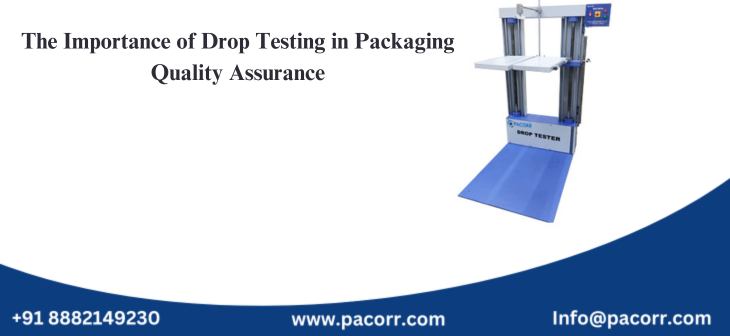
Packaging plays a crucial role in protecting products from damage during handling, transportation, and storage. A well-designed package ensures product integrity, enhances customer satisfaction, and reduces financial losses due to damage claims. However, packaging failures can result in significant setbacks, including product returns, dissatisfied customers, and increased costs. This is where drop testing becomes essential in packaging quality assurance.
Drop testing is a critical method used to evaluate a package’s ability to withstand the rigors of the supply chain. By simulating real-world drops, this testing helps manufacturers assess the durability, strength, and overall effectiveness of their packaging materials. Implementing drop testing as part of the quality control process can help companies optimize their packaging designs and improve product safety.
What is Drop Testing?
Drop testing is a standardized procedure that determines a package’s resistance to impact forces when subjected to free-fall drops from a specified height. The test measures how a package behaves under different impact conditions, replicating potential mishandling scenarios that can occur during shipping, loading, unloading, or consumer handling.
The test evaluates multiple factors, including:
- Structural integrity of the packaging material
- Cushioning efficiency of internal protective components
- Product damage levels after impact
- The ability of the package to retain its shape and protect contents
By conducting controlled drop tests, manufacturers can identify weaknesses in packaging designs and make necessary improvements to enhance durability and performance.
Why is Drop Testing Important in Packaging Quality Assurance?
1. Ensuring Product Protection
The primary purpose of packaging is to safeguard products from external damage. Fragile and high-value products, such as electronics, glassware, and pharmaceuticals, require robust packaging solutions to withstand rough handling. Drop testing ensures that packaging materials provide adequate protection, reducing the risk of product damage.
2. Reducing Product Returns and Financial Losses
A significant percentage of product returns are due to damage sustained during transportation. Returns not only increase operational costs but also impact customer trust and brand reputation. By identifying weak points in packaging through drop testing, manufacturers can mitigate damage risks and minimize costly returns.
3. Compliance with Industry Standards
Many industries require compliance with international packaging standards such as ASTM D5276, ISO 2248, and ISTA protocols. These standards define drop test parameters to ensure packaging meets performance requirements. Regular drop testing ensures that packaging aligns with regulatory guidelines, preventing legal and logistical issues.
4. Enhancing Customer Satisfaction
Consumers expect to receive products in perfect condition. Damaged packaging not only affects brand credibility but also leads to negative reviews and customer dissatisfaction. Implementing drop testing as a quality assurance measure ensures that products reach customers intact, enhancing brand loyalty and trust.
5. Optimizing Packaging Design and Cost Efficiency
Drop testing helps manufacturers fine-tune packaging designs by identifying the most effective materials and protective solutions. This prevents over-packaging, which increases costs, and under-packaging, which compromises product safety. Striking the right balance between protection and cost efficiency is key to sustainable packaging solutions.
How Drop Testing is Conducted
Drop testing is performed using specialized testing equipment that allows controlled and repeatable drop simulations. The process generally follows these steps:
- Preparation of the Test Sample – A sample package, including the product and all protective materials, is prepared according to testing guidelines.
- Selection of Drop Heights – The drop height is determined based on real-world handling conditions. Heights may vary based on package weight and industry standards.
- Defining Drop Orientations – Packages are dropped in different orientations, such as flat drop, edge drop, and corner drop, to analyze how different angles affect structural integrity.
- Conducting the Drop Test – The package is released from a controlled height using a drop tester, ensuring accurate impact measurement.
- Damage Assessment – After impact, the package and its contents are inspected for structural deformation, cracks, or product failure.
- Data Analysis and Reporting – The results are analyzed to determine whether packaging improvements are required for better protection.
Factors Affecting Drop Test Performance
Several factors influence the results of a drop test, including:
- Material Quality: The type and thickness of packaging materials impact the level of protection offered.
- Product Weight & Fragility: Heavier and more fragile products require advanced cushioning and stronger packaging materials.
- Drop Height & Frequency: Higher drop heights and multiple drops simulate extreme handling conditions, providing comprehensive durability insights.
- Packaging Design: Features such as corner reinforcements, internal padding, and shock-absorbing layers affect drop test outcomes.
Industries Benefiting from Drop Testing
Drop testing is widely used across various industries to ensure packaging durability and product protection. Some of the key industries that benefit from this testing include:
- E-commerce & Retail – Online shopping involves extensive shipping and handling, making durable packaging essential to prevent product damage.
- Electronics & Consumer Goods – Delicate gadgets require sturdy packaging to withstand accidental drops and transportation shocks.
- Pharmaceuticals – Medical supplies and drugs must be delivered intact to ensure safety and effectiveness.
- Automotive & Aerospace – Critical components must remain undamaged during transit to prevent functional failures.
- Food & Beverage – Proper packaging prevents contamination and ensures product integrity during distribution.
Advancements in Drop Testing Technology
With the rise of automated drop testers and high-speed impact analysis, drop testing has become more precise and data-driven. Modern drop testing machines allow manufacturers to capture real-time impact data, simulate different environmental conditions, and customize drop parameters based on specific product needs. Advanced sensors and imaging technologies further enhance the accuracy of impact assessments.
Drop testing is an essential component of packaging quality assurance, ensuring that products remain protected from damage throughout their journey. By integrating drop testing into quality control procedures, manufacturers can enhance packaging durability, reduce financial losses, meet compliance standards, and improve customer satisfaction.
As industries evolve and shipping complexities increase, investing in drop testing technology will become even more crucial for businesses striving to maintain packaging excellence. Companies committed to high-quality packaging solutions will not only gain a competitive edge but also build stronger trust with consumers.
Thanks to Pacorr Testing instruments, we have all the required quality testing instruments that have helped us to ensure the best quality delivered to our clients.

Danish
Fair Exports Pvt. Ltd.

